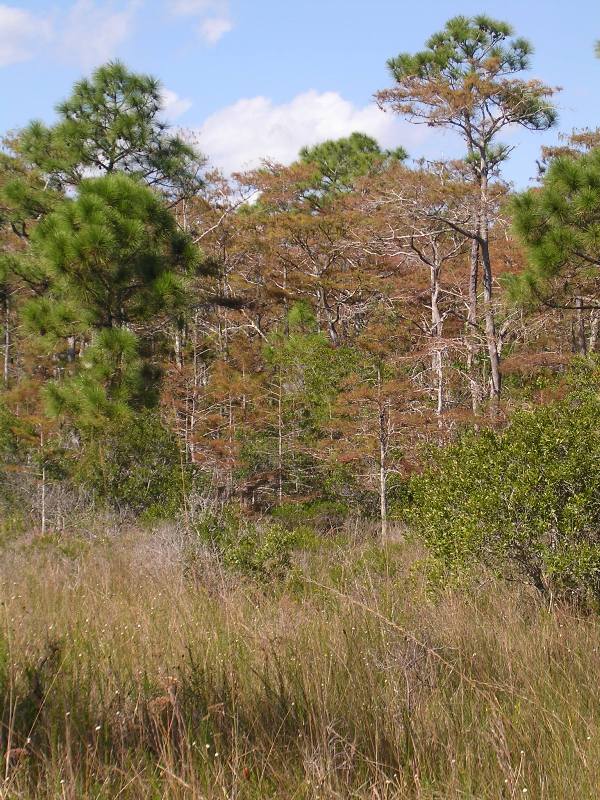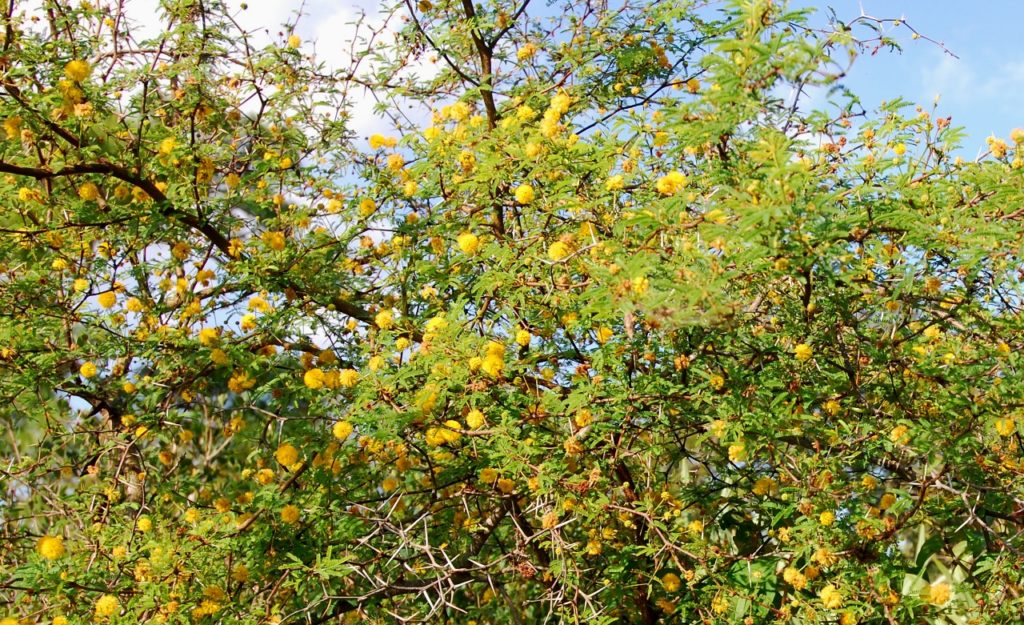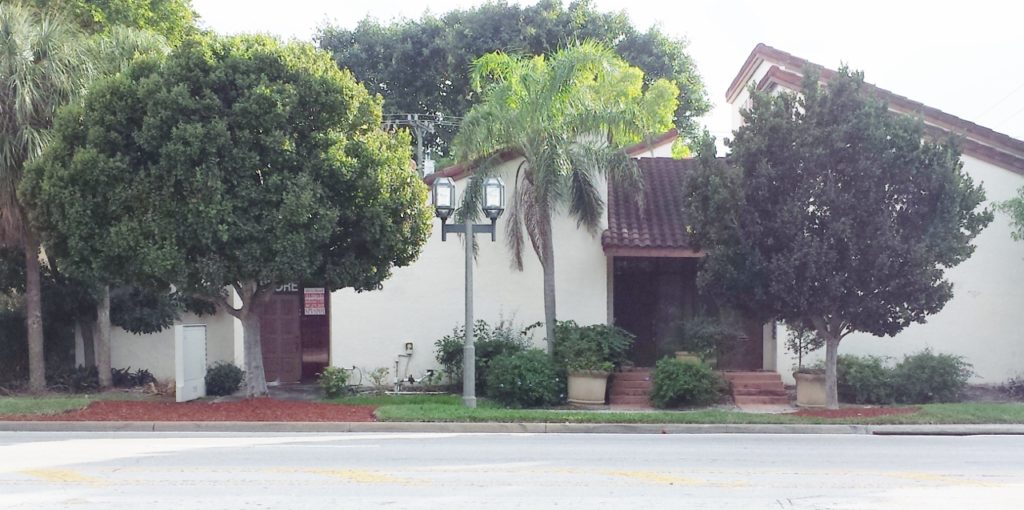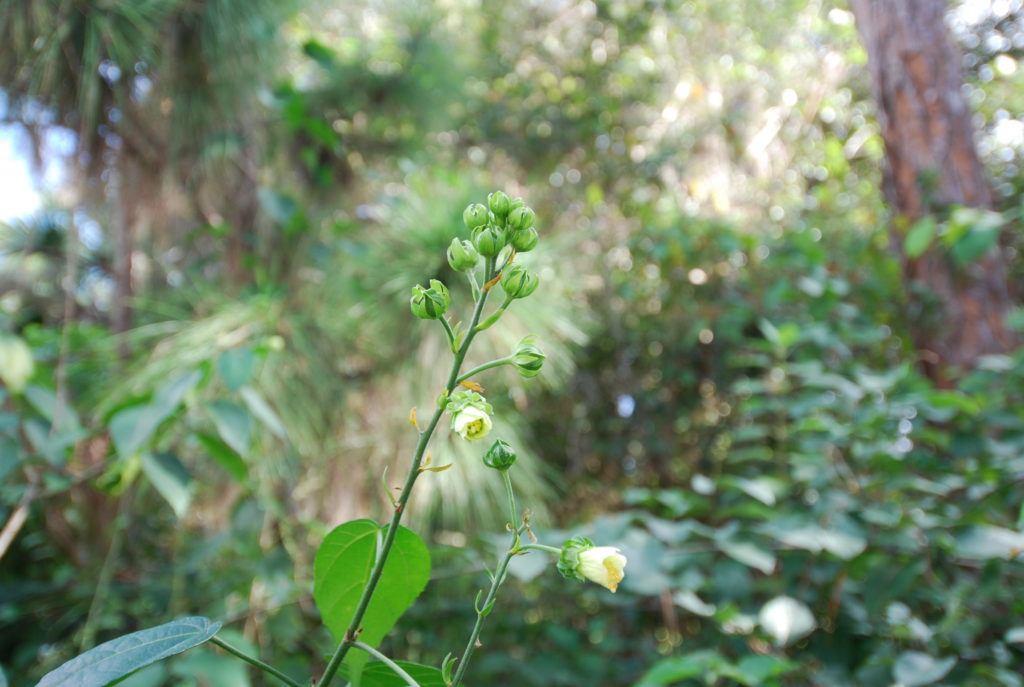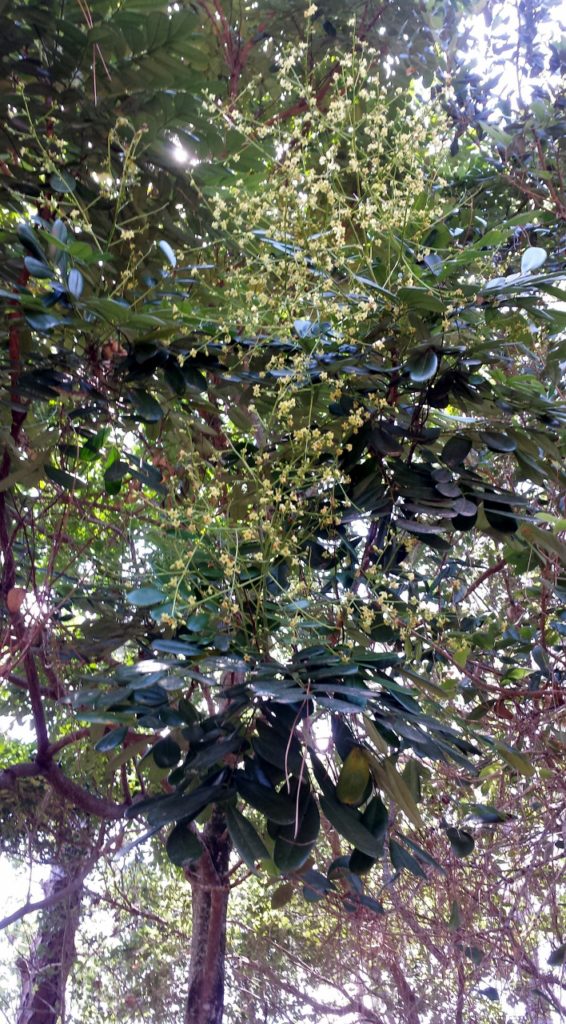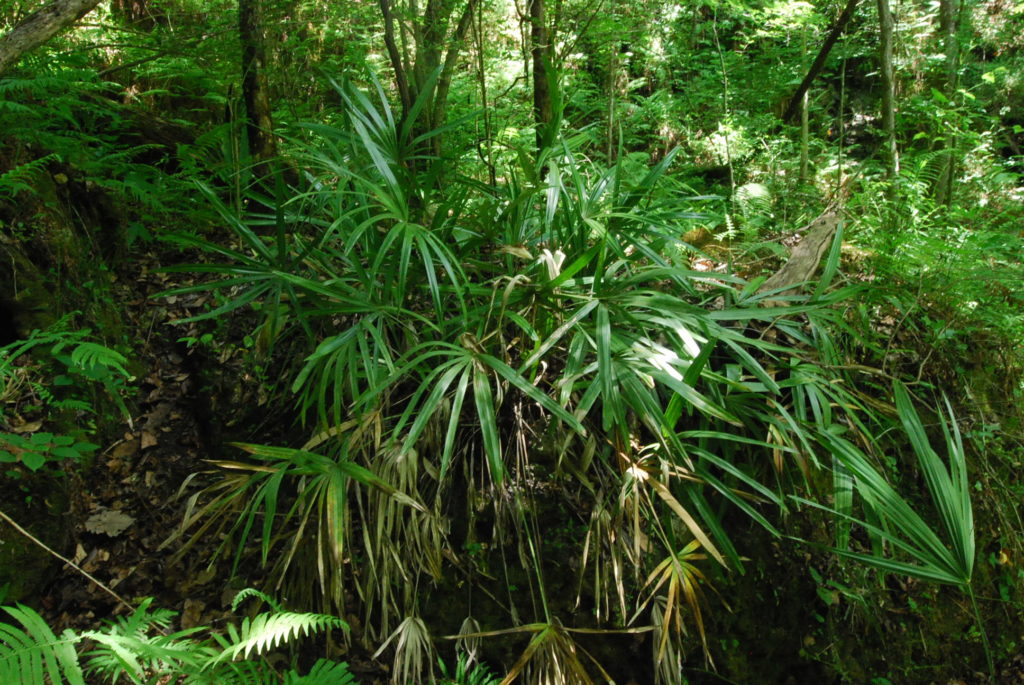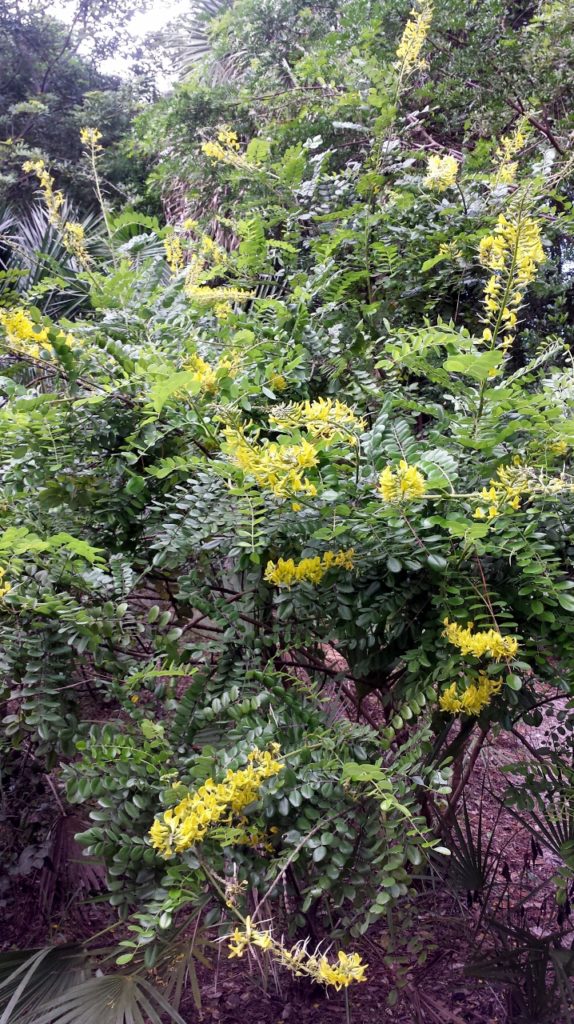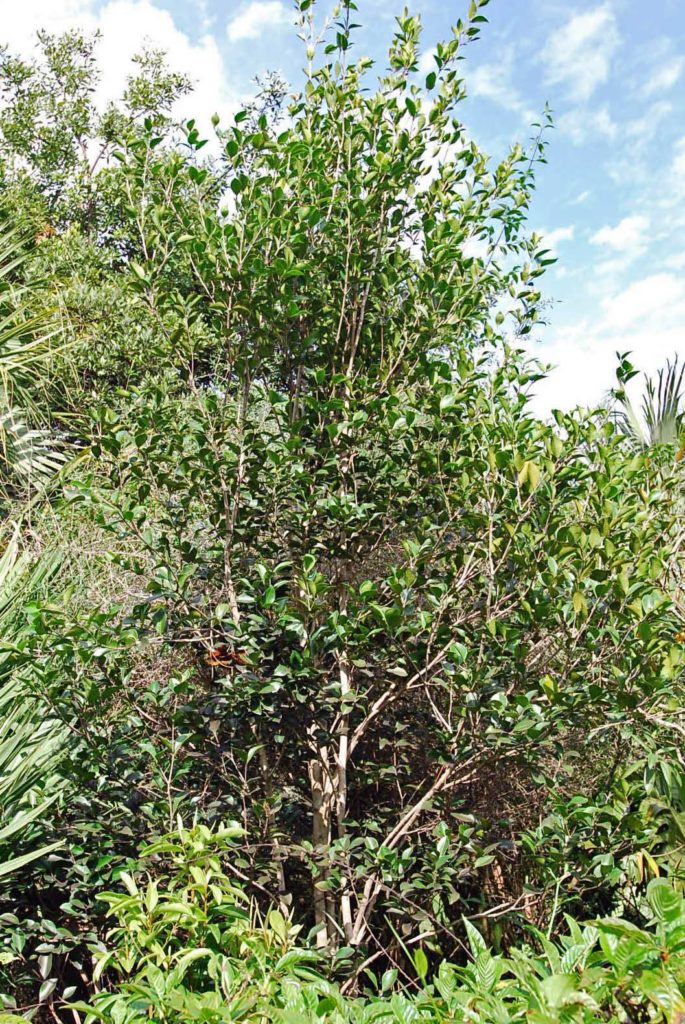Pond Cypress
Taxodium ascendens
Pond Cypress is found from Virginia to Miami Dade County. It is similar to the Bald Cypress and may even occur with it. The leaflets of Pond Cypress tend to circle the midrib, especially the upper ones, while the leaflets of Bald Cypress are flat like a feather and are softer than Pond Cypress.
Pond Cypress has branches that are less muscular than Bald and it can grow in less fertile soil. You will often find it mixed with Slash Pine in Florida where the soil is moist yet not very fertile. It also makes up cypress domes, like the ones you see in Everglades Park. Bald Cypress likes rich soil along sloughs, rivers and lakes, like lake Okeechobee.
The leaves of both drop in the fall leaving a stark landscape during winter, yet put on soft, light green leaves in the spring. During the stark times, air plants, orchids, ferns, and other shade tolerant plants grow and store energy for the rest of the year.
The wind pollinated flowers are in racemes (catkins) with male and female found separately on each tree. These are followed by a one inch round ball that contains angular seeds coated in hard resin. The seed will only germinate in moist soil where the seedling can grow tall enough to rise above floodwaters that would drown it during the summer rains.
Some wildlife will feed on the seeds including wood ducks and squirrels, yet they aren’t a great source of wildlife food the way oaks are. What this tree does provide are branches for epiphytes to grow on and roosts for many wading birds. These birds also build nests there if a Pond Cypress is growing out in the water where raccoons can’t swim to it.
Pond Apple is another good nesting tree that can be planted out in the water of a lake or pond. You can plant a six foot tall tree of either directly in water; it is just the seedling that will drown if covered during flooding season.
Pond Cypress will grow to 20 feet in 10 years if planted in average, moist soil. It will reach 100 or more feet in good soil, yet only your great, great grandchildren will have to worry about it falling on them as we know all tall trees are prone to do. By the way, how often do you read of a tree falling on someone and killing them compared with someone being injured by slipping in a shower?
This is a great tree to completely change the texture of the landscape. As you can see in the picture, the fine brown leaves of fall and the bonsai like branches mixed with dark green Slash Pine and wetland species make one of the most interesting pictures I have.
If you are lucky to have a low wet area of the yard that most likely had cypress in it before development just replant it with an oddly spaced forest of Pond Cypress, Red Maple, Sweetbay Magnolia, Swamp Redbay, Buttonbush, Virginia Willow, Leather Fern. Duck Potato, Thalia, Prairie Iris, Yellow Canna, Swamp and Marsh Ferns and other wetland species. Why fill the depression and grow sod?
Click here for more info. And here too.
Pineland Privet
Forestiera pinetorum
Pineland Privet is native to the Miami Rocklands and Everglades Park. This is a very drought tolerant plant that grows well thru Palm Beach County.
Plants are male and female with the males producing masses of flowers almost every month. These small white fragrant flowers attract many bees and butterflies, including Ruddy Daggerwings and Atala Hairstreaks. The bush will buzz with honeybees when in bloom, yet bees rarely sting when busy collecting nectar.
The female plants, which bloom less often, produce half inch long black fruit in early spring and late summer when the birds need them the most. These are bitter and may cause a stomach ache if many are eaten.
Use as a clipped hedge or a fluffy mass up to ten feet tall. The leaves drop briefly in the spring while the plant first flowers. If stem galling is noticed, cut off the twig below the gall with a clean tool and dip the tool in a ten percent chlorine solution between cuts.
The Pineland Privet is a must for butterfly gardens. It can be used as a ten foot tall background plant or mixed in with other tall shrubs.
Try mixing this with Bloodberry, Florida Keys Thoroughwort, Firebush, Florida Boxwood, Chapman’s Cassia, and Blackbead. Native Plumbago can be planted on the south side and allowed to form a six foot tall mass that also attracts many butterflies.
For a Rockland theme mix Pineland Privet with Southern Slash Pine, Tetrazygia, Beautyberry, Wild coffee, Marlberry, Myrsine, Guettarda scabra, Dahoon Holly, Saw Palmetto, Silver Palm, Coontie and the plants above.
If you want a one foot tall boxed hedge or edging, Pineland Privet will do well. It will, of course, produce few flowers and fruit when tortured this way.
For information about the related and similar Florida Privet click here.
Pineland Acacia
Acacia pinetorum
Pineland Acacia has a new scientific name of Vachellia farnesiana var. pinetorum. This is a native of the Keys and Miami Rocklands. It isn’t very tolerant of salt air or salt water flooding, but is very drought tolerant.
The tiny leaves add a distinct texture to the landscape and the small flowers in half inch yellow globes are very fragrant. I like to use this plant near areas where the fragrance of its flowers can be appreciated.
Although the growth is normally low, it will reach ten feet or more over time and makes an interesting small tree that you can walk under. This is a nice feature if you want to avoid the sharp spines. It is similar to what you would find in our American deserts.
If kept low, it makes a great mounding mass of spiney growth that keeps people out of more delicate areas of the garden. The spines are irritating, yet won’t tear the skin as Wild Lime will. The flowers are followed by three inch long tough pods containing several seeds.
This is the larval host for the Acacia Blue butterfly, which was once called the Nickerbean Blue. It migrates from the West Indies and can be found, if at all, on Big Pine Key and Bahia Honda. Pineland Acacia is not a great butterfly nectar plant, although it attracts other pollinators.
When planting a rockland or Keys theme, this is one of the plants that should be used. Mix it in with Lignum Vitae, Chapman’s Cassia, Locustberry, Indigo Berry, Joewood, Quailberry, Slash Pine, Rhacoma, Beautyberry, Tetrazygia, Pineland Privet, Bloodberry, Guettarda, Smooth Strongbark, Mexican Alvaradoa, Marlberry, Myrsine, Krugs Holly, Wild Coffee and the Thatch Palms.
Click for more info
Pigeon Plum
Coccoloba diversifolia
Pigeon Plum is widely used in landscapes and yards where a moderate sized tree with a tight rounded crown is needed. Its cousin Seagrape has similar, but rounded leaves and branches that spread out and basically take over the yard. Both trees in picture are Pigeon Plums.
The Leaves of Pigeon Plum are oval and from two to six inches long. This is where the diversifolia species name comes from. Young leaves are reddish and become dark green. There is a small weevil that will eat holes in the leaves of unhealthy trees. Just fertilize if necessary and the new growth will be fine. See this link for more info on pests.
Some salt air is tolerated considering that Pigeon Plum is native to our coastal hammocks from the Keys to Brevard County. Salt water flooding is not tolerated and rich soil is prefered. Once established, it becomes tolerant of long periods of drought.
The bark of Pigeon Plum is blotchy and provides interest to the landscape when combined with other trees with flaking bark. These include Gumbo Limbo, Simpson Stopper, Soldierwood and Poisonwood.
Many other tall hammock species can be added as well including Wild Tamarind, Paradise Tree, Redbay, Satinleaf, West Indian Cherry, Mastic and Jamaican Dogwood. These all grow to 40 or more feet like the Pigeon Plum.
The understory can include shade tolerant shrubs and groundcovers including Wild Coffee, Marlberry, Snowberry, Coontie, Wild Plumbago, Coastal Foxtail, Florida Thatch Palm, Key Thatch, Silver Palm, Dicliptera, Basketgrass and Boston Fern.
You will need at least two Pigeon Plum in order to get fruit. The trees are dioecious, so either plant several and remove the extra male trees when the females start fruiting or purchase plants that have already fruited in order to tell which ones are female. Birds and mammals love the fruit and the flowers attract butterflies.
The fruit of Pigeon Plum are dry by the time they fall from the tree so there is little mess compared to other more juicy berries like those of Seagrape. Both trees have edible fruit.
Click for more info
Pavonia
Pavonia paludicola
Pavonia, also known as Mangrove Mallow and Swampbush, is found in extreme South Florida. It is considered imperiled. The light green heart shaped leaves are only four or five inches long and look like a miniature Mahoe. It grows to 15 feet tall and can be kept shorter with annual pruning.
Although the plant is a bit rangy, the yellow flowers are a favorite of the local ruby throated and buff bellied hummingbirds. It keeps on flowering, even after a cold spell when the Firebush stops.
This is a good salt tolerant plant found near mangroves and does well in average soil and during a drought. Although it isn’t one of the most beautiful plants available, it can be planted in the background or tolerated near a window in order to provide a close up of your winter hummingbirds.
There is a Bahamian species, P. bahamensis, that is very similar. The stamens protrude from the tubular petals, where P. paludicola is level with them.
A butterfly-hummingbird garden should include this plant. Place it on the north side of the garden and mix with other tall, bushy, pushy shrubs and small trees, since it will fill all of the space from ground up where you plant it.
Companions include Firebush, Pineland Privet, Bloodberry, Florida Boxwood, Limber and Jamaica Caper, Blackbead, Wild Lime if given extra room to spread out, Native Plumbago when allowed to become a thick mound and Bahama Strongbark.
Click for more info
Paradise Tree
Simarouba glauca
Paradise Tree is one of our most tropical looking trees with shiny, dark green compound leaves and a straight trunk that can grow to 50 or 60 feet tall. The 16 inch long leaf has 16 or more three inch oval leaflets.
This tree is found in the Florida Keys and along the coast up to Brevard County. It can tolerate some salt air, but little salt water flooding and is very drought tolerant in average soil. Rich soil will give you a faster growing tree and darker green foliage though.
Paradise Tree is not tolerant of cold air and one inch diameter branches along with all the leaves will be damaged at forty degrees. A freeze may cause extensive loss of branches.
It is surprising to find Paradise Tree naturally in tree islands and moving onto high ground along roadways on the north end of Apoxee trail. This preserve is west of the Turnpike in West Palm Beach. It can also be found in Corbett Wildlife Management Area.
Other hammock species can be found in these unlikely areas including Wild Coffee, White Stopper, Marlberry and Graytwig (Schoepfia schreberi). It is nice to know that by planting our coastal trees in areas west, you are just speeding up the natural movement of these plants.
The higher, more fertile ground with protection from cold air that our new communities provide is a natural place for these plants to move into. Too bad the invasive exotics often beat them there first.
The flowers attract many pollinators in April and the olive sized fruits feed wildlife. The fruit are bitter, yet not poisonous. You will need to plant a male and female in order to have fruit on this dioecious tree.
Paradise Tree mixes well with other coastal and Keys’ trees. For a dense canopy similar to what you might see in the Keys try spacing a variety of trees from three to thirty feet apart in a random manner.
Plant a tight group of five different kinds of trees only three to ten feet apart with others farther away. The close trees will become one canopy with a mixture of bark types and clean lower trunks. These can include Mastic, Pigeon Plum, Wild Tamarind, Poisonwood, Fishfuddle, Gumbo Limbo, Satinleaf, Soldierwood and Soapberry.
Paradise Tree also makes a great stand alone specimen in the front yard. The understory can be any mix of shrubs and ground covers although Coontie, Beach Creeper, low growing Snowberry and managed Wild Plumbago will really set it off.
Click for more info
Needle Palm
Rhapidophyllum hystrix
Needle Palm is the most cold tolerant palm in the United states. It naturally grows from Central Florida up to coastal Southeast South Carolina. It can be grown in Washington DC and states where winter temperatures stay above 0 degrees F.
The base will produce additional stems and form a clump four or more feet across and four feet high. The dark green fan shaped leaves are six feet long including the petiole so that the entire plant may reach 10 feet or more in height.
At the base of the leaves are 10 inch skewers that are quite sharp and painful. Do not stick your hand down to the base when cleaning out debris. The plants are either male or female (dioecious) with the female plant producing one inch round nutlike seeds in a cluster if there is a male nearby for pollination.
Soil must be rich and preferably moist, yet it can tolerate wet soils too. Average soil is fine, but you will need to use slow release fertilizer every 3-6 months if the plants stop growing and start dying back. Light shade is best although full sun is OK. Needle Palm is not salt tolerant.
There are many Needle Palms in North Florida growing on hillsides near rivers and springs. These tend to grow like a Saw Palmetto with the active growth pushing forward and rooting along the ground while the old stem dies behind it.
I have planted some in dry soil with high organic matter content and no more watering than to establish it in one month. It can be used in a moist woodland planting mixed with Red Maple, Sweetgum, Water Hickory, Bald Cypress, Laurel Oak, Live Oak and Sweet Bay Magnolia.
Other understory plants may include various ferns, Coontie, Salvia, Prairie Iris, Yellow Canna, Florida Lily, American Crinum Lily and other shade tolerant wildflowers and low shrubs.
click for more info, and more info, and even more info
Necklace Pod
Sophora tomentosa var. truncata
Necklace Pod or Yellow Necklace pod is naturally found from the Florida Keys to Brevard County mainly along the coast. Make sure when you purchase this plant that it is the native variety truncata and not Sophora tomentosa var. occidentalis which is from the West Indies.
The native variety has new growth with short soft hairs that become glabrous or hairless about four leaves down from the top. It grows to eight or more feet tall over several years. The non native variety occidentalis has all leaves with short soft hairs and tends to be shorter than six feet tall. It also seems to die out after a few years.
Although the native Necklace Pod is tolerant of moderate amounts of salt air, it doesn’t tolerate more than brief periods of salt water flooding. Drought tolerance is excellent and dry soil with just a little organic matter is fine. The tap root is large and goes deep.
To keep Necklace Pod short, just cut it to the ground each February. It will send up many new canes and flower by summer. Do not try to cut it back to two or three feet, it will look…weird. Hummingbirds and bees like to nectar on the flowers and a moth caterpillar may occasionally show up and eat some of the leaves. More for birds to eat. Do not try eating the seeds, they are poisonous.
The silvery soft leaves are welcoming and go well near the entrance to your home. Try mixing with Sea Lavender, Sea Oxeye Daisy, Blue Saw Palmetto, Silver Palm, Key Thatch, Bitter Panicum, Sea Oates, Pineland Croton and Pineland Strongbark for a real silvery combination.
Other beach plants can be used like Coontie, Dune Sunflower, Gaillardia, Beach Verbena, Beach Cocoplum, Blackbead, Joewood, Lignum Vitae, Black Torch, Coralbean and Indigo Berry.
click for more info
Myrtle of the River
Calyptranthes zuzygium
Myrtle of the river is another member of the guava family that produces clusters of white flowers in summer followed in early fall by half inch black berries that are favored by birds and are sweet and edible.
Although it can be clipped as a hedge, the best use is as a 10 to 25 foot small specimen tree. The growth is naturally rounded, yet taller than broad.
Found naturally in the upper Keys and parts of Dade County, Myrtle of the River survives well throughout Palm Beach County and can tolerate freezing temperatures for short periods.
Average soil, with some organic matter to retain moisture is best. Does very well during drought and can grow near the coast if protected by other vegetation.
Cardinals seem to like nesting in this shrub. When planted near your home, hawks are less likely to bother nesting birds and your dog will keep cats away. This is a combination that many birds take advantage of by placing their nest just above the height of your dog’s nose where predators from above and below feel unsafe.
This shrub can be mixed with coastal species or blended with rockland plants. In this latter case mix with Slash Pine, Tetrazygia, Pineland Privet, Saw Palmetto, Coontie, Wild Coffee, Silver Palm, Beach Creeper, Spanish Stopper, Locust Berry and other rockland species.
Like many of our trees and shrubs, Myrtle of the River may accumulate Lobate Lac Scale on its branches. This causes blackening on the leaves as the sugar syrup that the scale excretes becomes moldy. Just spray with your favorite organic pesticide labeled for scale insects and the mold will wash off in the rain.
For information on this scale insect click here, but please stay away from the imidacloprid containing pesticides that cause Colony Collapse of bees.
Click here for more info
Myrsine
Rapania punctata
Myrsine is a suckering native shrub that makes a dense screen. It is found naturally from the upper keys to Volusia county, both along the coast and inland.
Inland, it is found along the edge of wetlands and prefers moist to occasionally wet organic soil. Along the coast it is exposed to salt air and rich, dry soil. Myrsine is best grown in average soil with some organic matter and full sun to light shade.
Dioecious flowers are small and white, followed by BB size, black, one seeded hard berries on the female plants in late summer. These remain for most of the winter and feed migrating and local birds.
Although this is used as a hedge, it looks awful when boxed, as most shrubs do. Best if used as a natural screen that is cut back to an alternate leader once a year to keep it low. It can also be allowed to grow to 12 feet or more. A group or a freestanding specimen 30 feet tall is impressive.
This shrub seems most at home as part of a pineland planting. Plant Slash Pine trees, Saw Palmetto, Dahoon Holly, Beautyberry and Wild Coffee with groups of Myrsine. You can place your bench within the privacy of one these groups and disappear from neighbors or passers by. Try under planting with swamp fern for a real woodsy feel.
Myrsine can be added to your favorite mix of coastal plants like Spanish Stopper, Simpson Stopper, Fiddlewood, Marlberry, Firebush, Wild Coffee, Saw Palmetto, Coralbean, Beach Cocoplum, Blackbead, Jamaica Caper and Florida Privet.
click for more info
